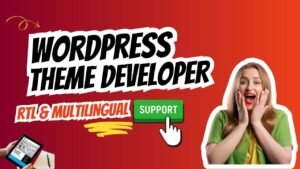Learn everything about block-first theme development in WordPress — from Full Site Editing (FSE) and block patterns to global styles and JSON-based templates. A complete guide for developers building modern, efficient, and future-ready WordPress themes.
Block-First Theme Development in WordPress: Building With Full Site Editing and Modern Templates
Introduction
The WordPress ecosystem is evolving faster than ever — and the shift from classic PHP-based theming to block-first theme development marks a new era for creators, developers, and designers alike.
If you’ve been developing WordPress themes the traditional way, with functions.php, header.php, and footer.php, you’re about to experience a massive paradigm shift. WordPress’s Full Site Editing (FSE) architecture empowers developers to design, customize, and control every part of a website visually — powered entirely by Gutenberg blocks and JSON-based templates.
This article breaks down what “block-first” development really means, why it’s the future of WordPress, and how to build modern block themes using templates, parts, patterns, and global styles.
1. Understanding the Block-First Concept
“Block-first” means designing and coding themes primarily using the block editor, rather than traditional PHP template tags.
Every part of a site — header, footer, sidebar, hero section, or even navigation — is treated as a block. These blocks are reusable, customizable, and editable directly inside the WordPress editor.
In short, the block editor becomes the foundation of your entire theme.
Key Idea
Instead of defining layout and structure through PHP templates, developers now create block templates and patterns that WordPress can render visually in the site editor.
2. What Is Full Site Editing (FSE)?
Full Site Editing (FSE) is WordPress’s approach to unify design and content editing. Introduced in WordPress 5.9, FSE allows users to customize their entire site — from header to footer — directly from the editor interface.
With FSE, there’s no need for separate “Customizer,” “Widgets,” or “Menus” sections. Everything lives inside one streamlined site editor, powered by blocks.
Core Components of FSE
-
Block Templates Define full-page layouts using Gutenberg blocks.
-
Template Parts Reusable sections (e.g., header, footer).
-
Global Styles (theme.json) Control colors, typography, and spacing site-wide.
-
Block Patterns Pre-designed layouts for quick page building.
-
Navigation Block Replace traditional menus.
3. Classic vs. Block-Based Theme Development
Let’s compare how themes worked before and after the block revolution
Feature | Classic Theme | Block Theme |
Structure | PHP templates (header.php, footer.php) | HTML templates with block markup |
Styling | CSS + Customizer | Global Styles via theme.json |
Editing | Limited via Customizer | Visual editing with FSE |
Menus | Managed in Admin Panel | Navigation block in editor |
Widgets | Managed via sidebar | Widget blocks directly on pages |
Flexibility | Requires code changes | No-code customization possible |
With block themes, developers and users finally work within the same interface, making design and development seamless.
4. Automating Content Creation
A standard block-first theme has a cleaner, simpler file structure than traditional ones.
Here’s a typical example
my-block-theme/
│
├── style.css
├── functions.php
├── theme.json
├── templates/
│ ├── index.html
│ ├── single.html
│ ├── archive.html
│ └── 404.html
│
├── parts/
│ ├── header.html
│ ├── footer.html
│
├── patterns/
│ ├── hero-banner.php
│ ├── call-to-action.php
│
└── screenshot.png
Explanation
-
theme.json Central configuration file controlling typography, color palettes, and layout.
-
Templates/ HTML templates replacing old PHP files.
-
Parts/ Template parts like header and footer.
-
Patterns/ Predefined design blocks are reusable across pages.
This modular structure makes your theme lightweight and fully compatible with the WordPress Site Editor.
5. The Role of theme.json (Global Styles)
The theme.json file is the backbone of block-first design. It defines your theme’s default settings and styles — colors, fonts, spacing, and more — in one place.
Example snippet
{
“version”: 2,
“settings”: {
“color”: {
“palette”: [
{ “slug”: “primary”, “color”: “#2C7A7B”, “name”: “Primary” },
{ “slug”: “secondary”, “color”: “#E2E8F0”, “name”: “Secondary” }
]
},
“typography”: {
“fontSizes”: [
{ “slug”: “small”, “size”: “14px”, “name”: “Small” },
{ “slug”: “large”, “size”: “32px”, “name”: “Large” }
]
}
},
“styles”: {
“color”: { “background”: “#ffffff”, “text”: “#1A202C” },
“typography”: { “fontFamily”: “Open Sans” }
}
}
This file eliminates the need for repetitive CSS definitions and enables global styling control for both developers and end users.
6. Creating Templates and Template Parts
Block templates are stored as .html files and are composed entirely of block markup.
Example
templates/index.html
<!– wp:template-part {“slug”:”header”} /–>
<!– wp:group {“tagName”:”main”} –>
<!– wp:post-title /–>
<!– wp:post-content /–>
<!– /wp:group –>
<!– wp:template-part {“slug”:”footer”} /–>
And a reusable header
parts/header.html
<!– wp:group {“align”:”full”} –>
<!– wp:site-logo /–>
<!– wp: navigation /–>
<!– /wp:group –>
Each file corresponds directly to a visual layout in the Site Editor, meaning you can edit them visually without touching code.
7. Block Patterns: Pre-Built Layouts for Speed
Block patterns are reusable, ready-made layouts that developers can register within the theme.
Example patterns/hero-banner.php
<?php
register_block_pattern(
‘mytheme/hero-banner’,
array(
‘title’ => __( ‘Hero Banner’, ‘mytheme’ ),
‘description’ => _x( ‘A full-width hero with image and call-to-action.’, ‘Pattern description’, ‘mytheme’ ),
‘content’ => ‘
<!– wp: cover {“url”: “path/to/image.jpg “, “dimRatio”: 50,” align”: “full”} –>
<div class=”wp-block-cover__inner-container”>
<!– wp:heading {“textAlign”:”center”} –>Welcome to Our Store<!– /wp:heading –>
<!– wp:buttons {“align”:”center”} –>
<!– wp:button –>Shop Now<!– /wp:button –>
<!– /wp:buttons –>
</div>
<!– /wp:cover –>
‘
)
);
When registered, this pattern appears inside the editor under “Patterns,” letting users quickly build pages with branded layouts.
8. Advantages of Block-First Theme Development
-
Visual Editing Experience No code changes needed for design tweaks.
-
Faster Development JSON templates and reusable blocks simplify workflow.
-
Lightweight Performance No excessive PHP or redundant CSS.
-
Better UX for End Users Clients can customize directly in the editor.
-
Future-Proof Design 100% aligned with WordPress’s roadmap.
-
Seamless Integration with AI Tools Block themes work naturally with AI pattern generators and automation tools.
Essentially, block-first development allows developers to build smarter and deliver faster.
9. Tools and Plugins to Enhance Block-First Workflow
Here are the must-have tools for efficient block theme development
Tool | Purpose |
Create Block Theme | Official WP plugin to create and edit block themes easily. |
Block Theme Generator | Generate base files for templates, parts, and theme.json. |
Gutenberg Plugin (Beta) | Access cutting-edge block features before core release. |
WP-CLI | Automate theme scaffolding and deployment. |
AI Assistants (like ChatGPT) | Generate pattern code, color schemes, and layouts quickly. |
10. Common Mistakes Developers Should Avoid
-
Overusing Inline Styles Let theme.json handle global design consistency.
-
Mixing Classic and Block Templates Stick to one paradigm per theme.
-
Ignoring Accessibility Ensure ARIA labels and semantic markup are included.
-
Not Testing Responsiveness Use editor previews for multiple devices.
-
Skipping Documentation Block-based themes need clear guides for editors and clients.
Remember: Block themes are powerful but demand clarity, modularity, and performance focus.
11. Future of Block-First WordPress Themes
As of 2025 and beyond, WordPress is doubling down on block architecture.
We’re already seeing
-
Pattern-based marketplaces are replacing old theme stores.
-
AI-assisted pattern creation for unique layouts.
-
Design systems integration via theme.json.
-
Cross-platform compatibility (e.g., React-powered WordPress apps).
For developers, embracing block-first is no longer optional — it’s the gateway to the next generation of WordPress innovation.
Top 10 Frequently Asked Questions (FAQs)
-
What does “block-first” mean in WordPress? It means developing themes using the Gutenberg block editor as the foundation — replacing traditional PHP templates with block-based HTML templates.
-
What version of WordPress supports Full Site Editing (FSE)? Full Site Editing officially launched in WordPress 5.9 and continues improving with each release.
-
Do block themes work with classic plugins? Yes, most plugins still work, though some may need updates for full compatibility with block-based architecture.
-
What is theme.json, and why is it important? It’s a configuration file that defines global design settings — like typography, colors, and spacing — for your entire site.
-
Can I convert an existing classic theme to a block theme? Yes, but it requires restructuring your templates and adding a valid theme.json file.
-
What are block patterns? They’re reusable pre-built layouts made of multiple blocks — ideal for building consistent page sections quickly.
-
How are block themes different from traditional themes? Block themes rely on visual editing and block markup instead of PHP template logic, making them more flexible and user-friendly.
-
Is coding knowledge still necessary for block-first development? Basic HTML, CSS, and JSON knowledge helps — but much of the process is visual, reducing the need for heavy coding.
-
Can I use AI tools to build block themes? Yes! AI tools like ChatGPT or WordPress AI builders can generate block templates, color schemes, and starter patterns.
-
Will block-based development replace classic themes completely? Eventually, yes. WordPress’s long-term roadmap centers around blocks, FSE, and pattern-driven design.
Conclusion
WordPress is entering a new design era powered by block-first development.
As a developer or designer, adopting this approach means faster builds, better UX, and compatibility with the future of web creation.
With FSE, theme.json, and pattern libraries, you can create fully customizable websites without writing repetitive code — giving both developers and end users more creative control than ever.

Monetising WordPress Themes & Plugins: Licence Models, Free-vs-Pro Strategy & Affiliate Marketing
Read More »
Theme Security Best Practices: Protecting Your Users and Building a Trusted Brand (2025 Edition)
Read More »





Leave a Reply